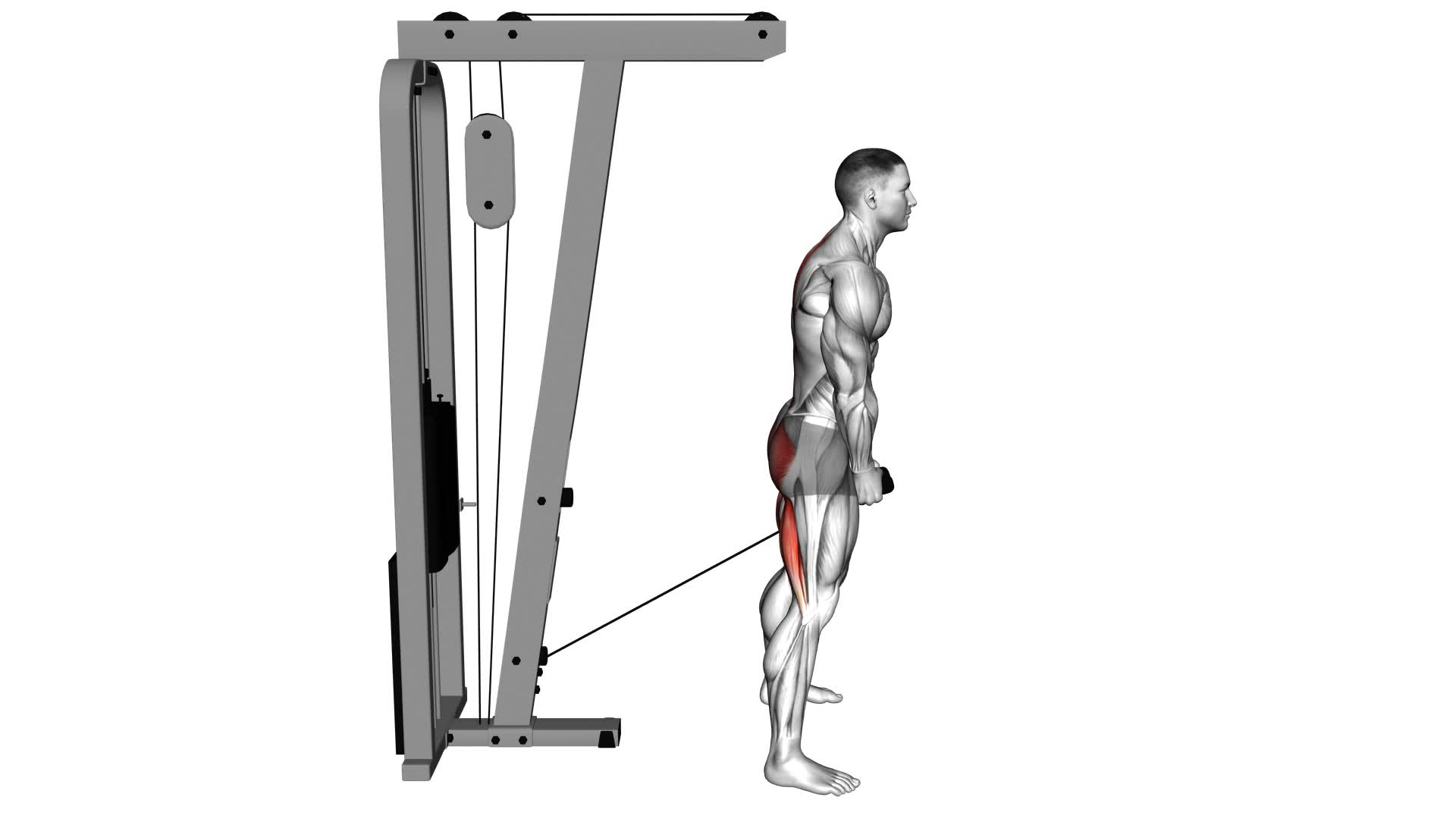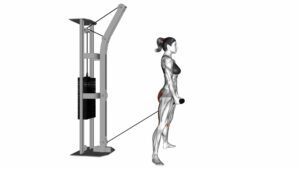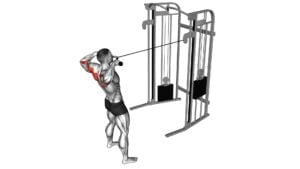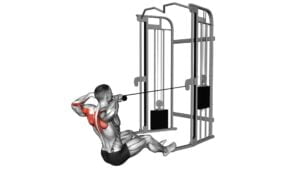Cable Pull Through (With Rope) – Video Exercise Guide & Tips

Are you looking to add a versatile and effective exercise to your routine? Look no further than the cable pull through with rope!
Watch This Exercise Video
This video exercise guide and tips will show you how to properly perform this move, and the equipment you'll need.
Discover the benefits, variations, and progressions to challenge yourself. Avoid common mistakes and maximize your results with this dynamic exercise.
Get ready to strengthen and tone with the cable pull through!
Key Takeaways
- Cable pull through engages multiple muscle groups simultaneously.
- It targets and strengthens glutes, hamstrings, and lower back.
- The exercise provides muscle activation for glutes, hamstrings, lower back, and core.
- Cable pull through improves hip mobility, flexibility, and reduces the risk of injury.
Benefits of Cable Pull Through
To understand the benefits of cable pull through, it's important for you to realize that this exercise engages multiple muscle groups simultaneously. Cable pull through exercises are a great way to target and strengthen your glutes, hamstrings, and lower back. By using a cable machine, you can adjust the weight and resistance to challenge yourself at different levels.
One of the main advantages of cable pull through exercises is the muscle activation they provide. When you perform this exercise, your glutes and hamstrings are the primary muscles being targeted. However, your lower back and core muscles also play a significant role in stabilizing and supporting your body throughout the movement. This means that not only are you working on building a strong and toned lower body, but you're also engaging your core muscles for added stability and balance.
In addition to the muscle activation, cable pull through exercises also help improve your hip mobility. As you perform the exercise, your hips go through a full range of motion, which can help increase flexibility and reduce the risk of injury.
Now that you understand the benefits of cable pull through exercises, let's move on to discussing the equipment needed for this workout.
Equipment Needed for Cable Pull Through
To properly perform the cable pull through exercise, you'll need some essential equipment.
Firstly, you'll need a cable machine with a low pulley attachment.
Additionally, you'll need a rope handle or a sturdy handle attachment for a secure grip.
Lastly, it's important to ensure that the cable machine is set to an appropriate weight for your fitness level.
Essential Equipment for Pull Through
You will need specific equipment for the cable pull through exercise. Here are three essential items you should have:
- Cable machine: This is the main piece of equipment for the cable pull through. It consists of a weight stack, a pulley system, and a cable attached to various handles or attachments.
- Rope attachment: A rope attachment is typically used for the cable pull through exercise. It allows for a secure grip and better control during the movement.
- Ankle strap: An ankle strap is necessary to secure the cable to your body. It wraps around your ankle and attaches to the cable, allowing you to perform the exercise safely and effectively.
Now that you know the essential equipment, let's move on to choosing the right gear for your cable pull through workout.
Choosing the Right Gear
Now that you have an understanding of the essential equipment for the cable pull through exercise, it's time to focus on selecting the appropriate gear for your workout.
Gear selection is an important aspect of any exercise routine, as it can greatly impact your performance and safety. When choosing the right gear for cable pull throughs, there are a few key factors to consider.
Firstly, make sure to select a cable machine with a smooth pulley system and adjustable weights. This will allow for smooth and controlled movements throughout the exercise.
Additionally, choose a rope attachment that's comfortable to grip and sturdy enough to withstand the tension.
Lastly, ensure that you have proper footwear to provide stability and support during the exercise.
Safety Considerations and Precautions
When considering safety and precautions for cable pull throughs, it's important to have the appropriate equipment. To prevent workout injuries and accidents, make sure you have the following items:
- A cable machine with a rope attachment: This will allow you to perform the exercise safely and effectively.
- Proper footwear: Wearing supportive athletic shoes will help you maintain stability and prevent slips or falls.
- An exercise mat: Placing a mat on the floor underneath you'll provide cushioning and reduce the risk of strain or discomfort.
Having the right equipment is crucial for avoiding workout injuries and ensuring a safe and effective cable pull through.
Now that you're equipped with the necessary gear, let's move on to discussing proper form and technique for this exercise.
Proper Form and Technique for Cable Pull Through
To perform the cable pull through exercise with proper form and technique, it's important to engage your glutes and hamstrings while maintaining a stable core throughout the movement. This exercise primarily targets the posterior chain, helping to strengthen and tone the glutes and hamstrings.
To begin, stand facing away from the cable machine with your feet shoulder-width apart. Attach the rope handle to the low pulley and position it between your legs. Grab the rope with an overhand grip, bending your knees slightly.
As you initiate the movement, hinge at your hips and push your glutes back, keeping your chest up and your spine neutral. Allow the cable to pull your hips back, feeling a stretch in your hamstrings.
To complete the exercise, reverse the movement by driving your hips forward and squeezing your glutes at the top. Be sure to maintain control throughout the entire range of motion.
Common mistakes in the cable pull through include rounding the back, using excessive momentum, and not fully engaging the glutes and hamstrings. It's important to focus on proper form and technique to maximize the effectiveness of the exercise and prevent injury.
Variations and Progressions for Cable Pull Through
Looking to challenge yourself with the cable pull through exercise? There are several variations and progressions you can try to take your workout to the next level. Here are three options to consider:
- Single-leg Cable Pull Through: This variation adds an extra challenge by requiring you to balance on one leg while performing the exercise. It targets your glutes and hamstrings even more intensely and helps improve stability and balance.
- Banded Cable Pull Through: Adding resistance bands to the cable pull through increases the difficulty and engages your muscles in a different way. The bands provide continuous tension throughout the movement, making it more challenging to control the weight.
- Weighted Cable Pull Through: If you're ready to increase the intensity, try adding weights to the exercise. You can use a weighted vest, dumbbells, or a barbell to make the movement more challenging and further strengthen your glutes and hamstrings.
Remember to start with the basic cable pull through and master your form before progressing to more advanced variations. Incorporating these progressions and variations into your routine will help you continue to challenge your muscles and achieve your fitness goals.
Common Mistakes to Avoid During Cable Pull Through
To ensure proper form and maximize the effectiveness of your cable pull through exercise, it's important to be aware of common mistakes to avoid during the movement.
By avoiding these errors, you can reduce the risk of injury and achieve optimal results.
One common mistake is rounding your back during the exercise. This not only puts unnecessary strain on your spine, but it also decreases the activation of your glutes and hamstrings. To maintain proper form, focus on keeping your back straight and your core engaged throughout the movement.
Another mistake to avoid is using excessive weight. Using too much weight can lead to improper form and compromise the targeted muscles. Start with a weight that allows you to perform the exercise with proper technique, and gradually increase the weight as you become stronger.
Lastly, rushing through the exercise is a common mistake. It's important to perform the cable pull through in a controlled manner, focusing on the contraction of your glutes and hamstrings. Take your time and concentrate on each repetition to ensure proper form and maximize the benefits of the exercise.
Tips for Maximizing Results With Cable Pull Through
To further enhance your cable pull through exercise, consistently incorporate these tips to maximize your results:
- Adjust the weight: To maximize muscle activation and intensity, it's important to use a weight that challenges you. Start with a moderate weight and gradually increase it as you become stronger and more comfortable with the exercise. This will ensure that you continue to make progress and see optimal results.
- Focus on form: Proper form is crucial for maximizing the effectiveness of the cable pull through. Keep your back straight, engage your core, and hinge at the hips while maintaining a slight bend in your knees. This will help you target the glutes and hamstrings more effectively, leading to better muscle activation.
- Control the movement: Avoid using momentum to complete the exercise. Instead, focus on controlling the movement throughout the entire range of motion. This will increase the intensity of the exercise and ensure that the targeted muscles are being properly engaged.
Frequently Asked Questions
How Many Sets and Reps Should I Do for Cable Pull Through?
For cable pull throughs, it's important to find the optimal weight and maintain proper form.
Start with a weight that challenges you, but still allows you to complete the recommended number of sets and reps. A good starting point is 3 sets of 10-12 reps.
As you progress, you can increase the weight and decrease the reps for more intensity.
Remember to focus on engaging your glutes and maintaining a neutral spine throughout the exercise.
Can I Use a Resistance Band Instead of a Cable Machine for This Exercise?
Yes, you can use a resistance band instead of a cable machine for the cable pull through exercise. Using a resistance band provides a portable and affordable alternative.
The cable pull through exercise primarily targets your glutes, hamstrings, and lower back. It helps improve your hip hinge movement, build lower body strength, and enhance overall stability.
Incorporating resistance bands into your workout routine can add variety and challenge to your exercises.
Can I Incorporate Cable Pull Through Into My Leg Day Workout?
Yes, you can definitely incorporate cable pull through into your leg day workout.
It's a great exercise for glute activation and can help strengthen your posterior chain.
To vary the exercise, you can try different cable pull through variations, such as using a rope instead of a cable machine.
Additionally, you can also incorporate cable pull through into a full body workout routine to target multiple muscle groups and increase overall strength and stability.
Is Cable Pull Through Suitable for Beginners or Should It Be Reserved for More Advanced Lifters?
For beginners, cable pull through can be a great addition to your leg day workout. It helps strengthen your glutes, hamstrings, and lower back.
To perform it properly, stand facing away from the cable machine, with the rope attached to your legs. Hinge at the hips, keeping your back straight, and push your hips back as you pull the rope through your legs.
Remember to engage your core and maintain proper form throughout the exercise.
Are There Any Specific Muscles That Cable Pull Through Targets More Than Others?
The cable pull through is a great exercise for targeting specific muscle groups. It primarily works your glutes, hamstrings, and lower back. By incorporating cable pull through into your full body workout routine, you can strengthen these muscles, improve your hip hinge movement, and enhance your overall athletic performance.
This exercise also helps in developing core stability and improving posture. So, don't hesitate to add cable pull through to your workouts for maximum benefits.
Conclusion
In conclusion, the cable pull through is a highly effective exercise that targets the glutes, hamstrings, and core muscles.
By using proper form and technique, you can maximize the benefits of this exercise and avoid common mistakes.
Additionally, variations and progressions can be incorporated to challenge your muscles further.
Remember to use the appropriate equipment and follow these tips to achieve optimal results with the cable pull through.

Author
Years ago, the spark of my life’s passion ignited in my mind the moment I stepped into the local gym for the first time. The inaugural bead of perspiration, the initial endeavor, the very first surge of endorphins, and a sense of pride that washed over me post-workout marked the beginning of my deep-seated interest in strength sports, fitness, and sports nutrition. This very curiosity blossomed rapidly into a profound fascination, propelling me to earn a Master’s degree in Physical Education from the Academy of Physical Education in Krakow, followed by a Sports Manager diploma from the Jagiellonian University. My journey of growth led me to gain more specialized qualifications, such as being a certified personal trainer with a focus on sports dietetics, a lifeguard, and an instructor for wellness and corrective gymnastics. Theoretical knowledge paired seamlessly with practical experience, reinforcing my belief that the transformation of individuals under my guidance was also a reflection of my personal growth. This belief holds true even today. Each day, I strive to push the boundaries and explore new realms. These realms gently elevate me to greater heights. The unique combination of passion for my field and the continuous quest for growth fuels my drive to break new ground.







